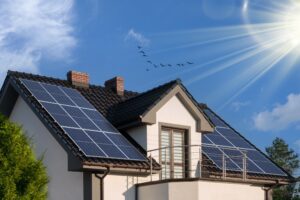If you’re thinking about installing solar panels to power your home or business premises, you’ll want them to generate as much electricity as possible to maximise savings on energy bills. Bifacial solar panels may be one option to achieve this.
Introduced in the 1960s, these double-sided solar panels have become an increasingly popular alternative to regular, single-sided (monofacial) solar panels.
In this post, we’ll explore everything you need to know about solar power and bifacial solar panels.
How Do Solar Panels Generate Power?
Photovoltaic (PV) solar panels convert energy from the sun into electricity.
Standard solar panels consist of silicon or another semiconductor installed in a metal panel frame with a glass casing. When the semiconductor is exposed to photons of sunlight – tiny packets of energy – it releases electrons and produces an electric charge.
This photovoltaic charge generates an electric direct current (DC), which is converted to an alternating current (AC) by an inverter so that it’s compatible with electrical systems.
Solar Cells
Solar PV panels commonly use monocrystalline or polycrystalline solar cells. Both types are made of silicon, the same material in electronic microchips.
The difference between monocrystalline and polycrystalline solar cells is how the silicon is configured.
Monocrystalline solar panels – sometimes just called mono solar panels – have solar cells with a single silicon crystal.
With polycrystalline solar panels – referred to as poly panels or multi-crystalline panels – each PV cell comprises multiple silicon crystal fragments bonded together.
Monocrystalline cells cost more but are more efficient with higher power capacity.
- Create a Tailored Quote Based On Your Circumstances
- Takes Less Than 2 Minutes
- Fixed-Online Quotes

Light Absorption
Solar panels function optimally in direct sunlight but also work in overcast weather or in partial shade. Less direct sunlight can actually be beneficial. High temperatures can reduce the power solar panels capture by up to 25%.
Traditional, monofacial solar panels are the most common type of photovoltaic panel, with solar cells that absorb light on the front side.
Benefits of Solar Power
With solar power, you can generate your own electricity to power your home or business property and save money by reducing dependence on the National Grid.
According to the Energy Saving Trust, solar panels can cut electricity bills by up to 70%. They can save you even more money if they’re combined with a solar battery storage system.
The cost of electricity generated by carbon-based fuels is likely to increase in the future as supplies start to run out. At the same time, advances in solar technology are making solar panels more affordable.
Solar panels may also increase the value of your home, and you can sell energy you don’t use back to the National Grid under the Smart Export Guarantee.
Unlike fossil fuels that pollute the atmosphere and drive climate change, solar power is a clean, renewable source of energy that reduces your carbon footprint.
What Are Bifacial Solar Panels?
Unlike monofacial solar panels, bifacial solar panels have solar cells on both sides. These cells also use a different technology.
Solar cells in bifacial solar panels – predominantly monocrystalline cells – are based on PERC technology, a major breakthrough in the solar industry.
PERC – Passivated Emitter and Rear Contact, also known as Passivated Emitter and Rear Cell – solves the problem of efficiency losses in conventional solar cells and generates more energy.
PERC solar cells in double-sided solar panels capture light at the back as well as the front. While monofacial solar panels have an opaque backsheet, double-sided solar panels have dual panes of tempered glass or a reflective backsheet.
This enables bifacial solar panels to absorb reflected light as well as direct sunlight.
How Bifacial Solar Panels Capture Light
Bifacial solar panels absorb light in four ways:
- Direct sunlight on the front of the panel.
- Direct sunlight reflected off the ground onto the back of the panel.
- Diffuse overhead sunlight on the rear of the panel.
- Diffuse sunlight reflected off the ground onto the rear of the panel.
To do this, the panels need to be installed on an elevated racking system that allows light onto the rear of the panels.
- Create a Tailored Quote Based On Your Circumstances
- Takes Less Than 2 Minutes
- Fixed-Online Quotes

Main Differences Between Bifacial Solar Panels and Monofacial Solar Panels
Most solar panels installed across the UK are monofacial types that generate energy solely from the front of the panels. Bifacial solar panels produce more electricity than regular solar panels because they absorb light on both sides. The extra surface area also enables them to work better in diffuse light.
Bifacial solar panels cost around 10% more than standard solar panels, and installation costs are also higher. Monofacial panels are cheaper to install because they’re lighter than bifacial panels and more flexible.
In return for the extra expense of dual-sided solar panels, you get a solar energy system that generates five to 30% more electricity than single-sided solar panels. The amount of additional energy produced depends on the environmental conditions surrounding the solar panels.
The power output from the rear of the panel will differ depending on how light-reflective the ground surface is where you install the panels.
When both sides of bifacial panels are covered by glass, they’re typically more durable than monofacial panels. They therefore generally come with a longer warranty than standard solar panels – up to 30 years – and they can continue generating free electricity long after this.
Designed to be completely transparent, bifacial solar panels usually have no metal gridline frames, which makes them structurally stronger and more visually appealing than monofacial panels.
Dual-sided solar panels are usually found in commercial settings. However, in some cases they can be used to power homes as well.
Where Can Bifacial Solar Panels Be Installed?
Sunlight reflects to some extent off everything. Bifacial solar panels ideally need to be around four metres from the ground, where the rear side can absorb sunlight reflected off the surface and generate as much solar energy as possible.
Double-sided solar panels aren’t designed for sloping rooftops of houses but can work well on flat roofs, although they’re generally more common on solar farms and in off-grid systems and commercial settings.
Bifacial solar panels work best when installed near a highly reflective surface such as stony or sandy ground.
Bifacial Solar Panels for Homes
Under the right circumstances, bifacial panels are suitable for some homes, particularly if they have a flat roof or you can install a system that takes full advantage of sunlight reflecting off the ground.
Dual-sided solar panels can also be incorporated into the design of home exterior structures such as a carport or a pergola. The open space beneath these outdoor coverings allows reflected light to reach the panel’s rear side.
It’s also possible to put double-sided solar panels on a sloping roof but only if they’re not mounted flush.
Advantages of Bifacial Solar Panels
The innovative design and pioneering solar cell technology of bifacial solar panels is revolutionising solar power, with benefits including increased efficiency, greater durability, and aesthetic appeal
Increased Efficiency
Compared with monofacial solar panels, bifacial solar panels capture more sunlight to convert into energy. The unique structure and larger light-absorbing surface area of double-sided solar panels can result in up to 30% more power. Because of this high level of energy efficiency, bifacial solar panels typically need less space to meet energy requirements.
Long-Lasting Durability
Bifacial solar panels are designed thicker to ensure structural integrity. This makes them more durable than monofacial solar panels and a reliable, long-lasting investment for harnessing clean energy. Double-sided solar panels are also UV (ultraviolet) light resistant and able to cope with strong winds and high temperatures.
Aesthetic Appeal
Bifacial solar panels, especially those with dual glass panels and no metal grid lines, are more aesthetically appealing because of their transparent nature. (The absence of a metal frame also reduces the risk of potential induced degradation – PID – of solar cells.
Disadvantages of Bifacial Solar Panels
Bifacial solar panels come with some drawbacks as well as benefits. These disadvantages include:
Initial Cost
With advanced design and materials, bifacial solar panels cost more to make than monofacial solar panels, and this is reflected in their market price – up to 10% higher.
Installation Cost
Bifacial solar panels weigh more than standard solar panels and need specialised mounting equipment. This makes them more expensive to install than conventional solar panels.
Variable Performance
The efficiency boost from the rear side of bifacial solar panels may be inconsistent, depending on the surrounding environment and surfaces.
Maintenance
Because bifacial solar panels are exposed on both sides, they may need cleaning more frequently to maintain optimal performance.
Role of Bifacial Panels in the Evolution of Solar Power
The unique design and enhanced efficiency of bifacial solar panels generate more energy than single-sided solar panels and optimise the amount of electricity generated per square foot of space. And the cost of dual-sided solar panels has fallen significantly in recent years.
For these reasons, solar industry insiders expect bifacial solar panels to continue rising in popularity among businesses and homeowners, gaining an increasingly larger global solar energy market share. At the same time, bifacial solar panels are proving to be a game-changing innovation in utility-scale solar power production.
So bifacial solar panels look set to play a pivotal role in the future of solar energy and the move towards sustainable energy.
- Create a Tailored Quote Based On Your Circumstances
- Takes Less Than 2 Minutes
- Fixed-Online Quotes




